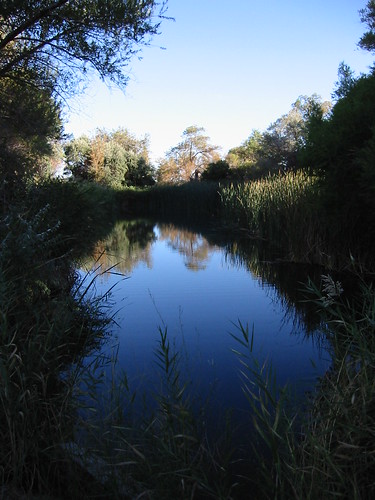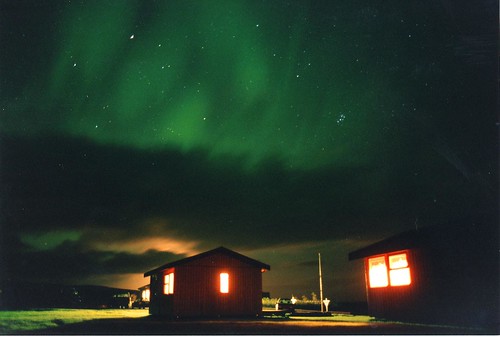Friday, December 02, 2011
"Wrong Emphasis on the Wrong Syllable"
I'm just putting this here because I would doubt Facebook or Twitter would archive very well. Mike Myers, in the movie "View from the Top", has a line "You put the wrong em-PHA-sis on the wrong syl-LA-ble". I was just watching the 1933 movie "Moonlight and Pretzels" at the Northwest Chicago Film Society showing, and a character in that movie does the exact same joke!
Monday, August 22, 2011
Refrigerator payback
My current fridge (a Hotpoint Foodcenter 24) is older than I am. It was originally the avocado color shown in the ad; at some point someone painted it black but only the front and the sides they could reach; the top back and sides were not. The spread control is appreciated but not used. The giant dust bunnies of a never cleaned coil underneath was not. I measured the yearly annual cost of this fridge at $290 a year with a kill-a-watt; at that rate, a really nice replacement will begin paying for itself in six years. The previous owners had this fridge for 15 years and paid over $4000 in electricity for the privilege.
http://books.google.com/books?id=2UwEAAAAMBAJ&lpg=PA10&ots=b1-UE37tSn&dq=hotpoint%20foodcenter%2024&pg=PA10#v=onepage&q&f=true
http://books.google.com/books?id=2UwEAAAAMBAJ&lpg=PA10&ots=b1-UE37tSn&dq=hotpoint%20foodcenter%2024&pg=PA10#v=onepage&q&f=true
Sunday, August 14, 2011
7.72 microRads/hr
A 39 day long sampling of every minute leads the geiger counter to a long term average of 7.72 uR/hr. That's 56658 sampling points. That's about what's it's always been.
http://www.blogger.com/img/blank.gif
http://www.blogger.com/img/blank.gif
Wednesday, July 20, 2011
Tuesday, June 28, 2011
Monday, June 13, 2011
Great Saturn Cassini video
Go out and see the Astronomy Picture of the Day for June 13th. It's an awesome video of the Saturnian system from Cassini. If all the cosmic ray hits, perspective changes (from Cassini's orbital motion), and dust donut hole moves(due to panning, filter changes, and zooms) are original to the raw images, then I salute Chris Abbas. What a great job.
Now compare that to my crappy gif animation I made of Enceladus and Dione near the rings from 5 years ago. http://dwarmstr.blogspot.com/2006/03/saturn-enceladus-and-dione-animation.html
Now compare that to my crappy gif animation I made of Enceladus and Dione near the rings from 5 years ago. http://dwarmstr.blogspot.com/2006/03/saturn-enceladus-and-dione-animation.html
Friday, June 03, 2011
Natural background radiation in Chicago
A recent inquiry brings up the question of what's the normal natural background radiation rate in Chicago? Using the EPA's online tool, we see the budget for naturally occurring sources listed as
(all numbers per year)
26 mrem for cosmic radiation
2 mrem for elevations up to 1000ft
46 mrem from terrestrial K, U, Th in soil (aka not Colorado Plateau or Gulf and Atlantic Coasts but normal US soil)
0 mrem from radon&daughter products (I'm excluding it here from this calculation but it's a sizeable percentage of your yearly dose)
74 mrem total, which comes out to about 8.4 urem/hr or microrems per hour. The long-term average in my basement office runs at about 7.6uR/hr.
From Duval, J.S., Aerial gamma-ray surveys of the conterminous United States and Alaska, you can see here that the approximate average exposure rate from naturally occurring U, K, and Th in the ground is about 4.5uR/hr at 1m above the ground for Chicago. I say about because the survey didn't look at heavily urbanized ground. But with the high resolution data and a geologic map you should be able to predict what it should be.

The Straight Dope unfortunately printed an error about it in 1980, claiming the rate in Chicago was 2 millirems per hour. That's really off; it's 1/250 of that.
(all numbers per year)
26 mrem for cosmic radiation
2 mrem for elevations up to 1000ft
46 mrem from terrestrial K, U, Th in soil (aka not Colorado Plateau or Gulf and Atlantic Coasts but normal US soil)
0 mrem from radon&daughter products (I'm excluding it here from this calculation but it's a sizeable percentage of your yearly dose)
74 mrem total, which comes out to about 8.4 urem/hr or microrems per hour. The long-term average in my basement office runs at about 7.6uR/hr.
From Duval, J.S., Aerial gamma-ray surveys of the conterminous United States and Alaska, you can see here that the approximate average exposure rate from naturally occurring U, K, and Th in the ground is about 4.5uR/hr at 1m above the ground for Chicago. I say about because the survey didn't look at heavily urbanized ground. But with the high resolution data and a geologic map you should be able to predict what it should be.

The Straight Dope unfortunately printed an error about it in 1980, claiming the rate in Chicago was 2 millirems per hour. That's really off; it's 1/250 of that.
Saturday, May 14, 2011
CFL lifetime report
I just noticed that a second CFL failed in my torchiere conversion I did back in the winter of 2008. I use this light about 7 hours a day consistently. That makes it just under 8000 hours. The first CFL failure I seem to have not mentioned; I think it happened about a year ago.
Monday, April 25, 2011
Sunday, April 24, 2011
The Las Vegas Anomaly
It seems all the iPhones as part of the once-unknown location tracking log all have visits to locations in northwest Las Vegas, all at the same time. Alasdair Allan and Pete Warden at O'Reilly Radar have dubbed this "The Las Vegas Anomaly", an elegant turn of phrase that will undoubtedly be incorporated into science fiction stories just as soon as writers get wind of it. Speaking as someone born and raised in Las Vegas, I have no clue why those locations are listed. There's not that much between the Kyle Canyon and Lee Canyon roads on US 95. A golf course, a small park, and scattered homes.
Sunday, April 17, 2011
Re: Magnetic Cable holders
Well, I had one issue with my magnetic cable holder: an incompatibility between the hot glue and the adhesive on a particular 'model' of holder. The ones with the adhesive and foam backing cleanly separated from the hot glue after a week or so under a slight load. I scraped the foam and adhesive off and reattached the magnet and the holder. I think part of the problem was difficulty in getting the hot glue thin enough before it set--this is a problem when attaching it to metal surfaces, which act as very efficient heatsinks. But other problem is the glue was not too gluey.
I've come across this incompatibility between hot glue and a few surfaces. The ubiquitous hot glue is EVA: Ethylene-Vinyl Acetate, a thermoplastic. I still need to make sure the adhering surfaces are hot glue compatible. It's really more about the convenience of the glue gun than anything else. I suppose I should be using a more universal glue for my generic adhesive requirements.
I've come across this incompatibility between hot glue and a few surfaces. The ubiquitous hot glue is EVA: Ethylene-Vinyl Acetate, a thermoplastic. I still need to make sure the adhering surfaces are hot glue compatible. It's really more about the convenience of the glue gun than anything else. I suppose I should be using a more universal glue for my generic adhesive requirements.
Sunday, March 27, 2011
Magnetic cable organizer/holder from hard drive magnets
I was talking with a coworker who had a particular design problem. Her network jack was embedded in a counter and the cable ran all the way across a built-in drawer to her desk and would frequently get jammed in the drawer. I suggested to her to talk to the Facilities guys to get some sort of cable management installed (as that's not my bailiwick) but I knew that the problem would persist into the future. I also thought there was little place to install anything that required a drilled hole, as there was AC conduit and such in the area. Then I had an inspiration: the network jack had been installed in a flat steel conduit. And I had a lot of hard drive magnets. So a little hot glue, some adhesive cable holders (that never really held very well), and I've got a solution! And now I'm making a bunch more for better cable management in my server room. I stuck a paper sticker on the magnet side to help prevent some of the surface marring these magnets can produce; a felt would probably be a better material.
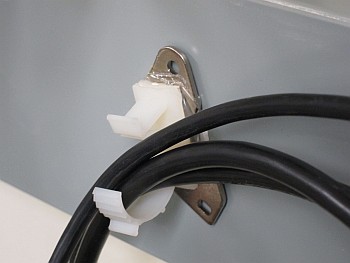
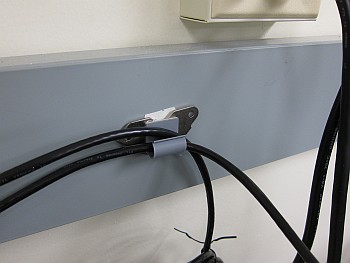


Wednesday, March 16, 2011
Geiger Counter back up
My long-suffering Geiger counter is now back up and running.
http://www.lib.uchicago.edu/~dean/float.htm.
Now, as has been pointed out, this particular instance of this experiment is really an experiment, and is run only by me, for only experimental purposes. It doesn't represent any opinion or endorsement or opinion of any entity, whether the University of Chicago Library or the University or anything else. It is not a service. It represents nothing, is not calibrated, and should not be relied upon by anyone for anything. Don't email or call anyone but myself about it.
This instance is located in my office on the A-level of the Regenstein Library, the first basement level of a six-story building. The levels average about 8 microrads/hr here. Outside at Ryerson Physical Laboratory on the fifth floor, levels average to about 12 microrads/hr, which indicate the shielding provided by the Regenstein against the cosmic ray flux.
The problem I've been having with this counter was with the associated AW-SRAD software, which runs under DOS, doesn't appear to support virtual COM ports above COM4. On my Windows XP PC I had installed an Arduino which offered a similar USB Serial converter and I theorize at some point there was a conflict and the Geiger counter with its FTDI USB to serial converter took a high COM port at COM5. After removing the Arduino, I then disabled the real serial port at COM1 and forced via Device Manager->Ports->USB Serial Ports the port to go to COM1.
http://www.lib.uchicago.edu/~dean/float.htm.
Now, as has been pointed out, this particular instance of this experiment is really an experiment, and is run only by me, for only experimental purposes. It doesn't represent any opinion or endorsement or opinion of any entity, whether the University of Chicago Library or the University or anything else. It is not a service. It represents nothing, is not calibrated, and should not be relied upon by anyone for anything. Don't email or call anyone but myself about it.
This instance is located in my office on the A-level of the Regenstein Library, the first basement level of a six-story building. The levels average about 8 microrads/hr here. Outside at Ryerson Physical Laboratory on the fifth floor, levels average to about 12 microrads/hr, which indicate the shielding provided by the Regenstein against the cosmic ray flux.
The problem I've been having with this counter was with the associated AW-SRAD software, which runs under DOS, doesn't appear to support virtual COM ports above COM4. On my Windows XP PC I had installed an Arduino which offered a similar USB Serial converter and I theorize at some point there was a conflict and the Geiger counter with its FTDI USB to serial converter took a high COM port at COM5. After removing the Arduino, I then disabled the real serial port at COM1 and forced via Device Manager->Ports->USB Serial Ports the port to go to COM1.
Tuesday, March 15, 2011
What's in the steam coming from a nuclear reactor
I've hesitated to comment much on the ongoing Japanese tragedy, but I wish to talk a little about the output coming out from the reactor whenever they open the valves to reduce the pressure inside. In commerical nuclear reactors not using heavy-water for their coolant (aka most non-Canadian western reactors) the pure water coolant is exposed to the intense neutron flux as it passes through the reactor. The neutrons can interact with the oxygen nuclei in the water to form nitrogen-16, a very short lived radioisotope with a half-life of seven seconds. After a few minutes away from the core there is none of it left so the only hazard is near the output pipe, and there are places they store the output for just a little while to let all of the N-16 to decay back into oxygen-16.
The other common isotope coming out is tritium coming from the small amount of deuterium in normal water, leaking through the fuel rod cladding, and other spalling type nuclear reactions in the materials in the core. The tritium is a low radioactive hazard but has a 12-year half-life.
If the reactor is hot, water will decompose into hydrogen and oxygen, especially with the right catalysts.
So if you were to open the output valve on a reactor to relive the steam pressure inside (because the regular cooling is not working), you would get quite a bit of that nitrogen-16. It would be gone by the time a few minutes of wind-time, but it is quite the hazard to the plant. I wonder how much of the periodic bursts of site limit radioactivity is related to that.
The introduction of seawater into the cores introduces the possibility of neutron activation of a number of other elements (sodium, chlorine, etc.) into radioactive isotopes that last longer and can have more of an issue in life time and clean up.
None of this discussion is about the breaking or melting of the cladding and detection of fission products (like what you see when checking people on their clothing for particles), which seems to have occurred in some fashion.
A good primer on what might be going on, without hysteria is over at MIT.
The other common isotope coming out is tritium coming from the small amount of deuterium in normal water, leaking through the fuel rod cladding, and other spalling type nuclear reactions in the materials in the core. The tritium is a low radioactive hazard but has a 12-year half-life.
If the reactor is hot, water will decompose into hydrogen and oxygen, especially with the right catalysts.
So if you were to open the output valve on a reactor to relive the steam pressure inside (because the regular cooling is not working), you would get quite a bit of that nitrogen-16. It would be gone by the time a few minutes of wind-time, but it is quite the hazard to the plant. I wonder how much of the periodic bursts of site limit radioactivity is related to that.
The introduction of seawater into the cores introduces the possibility of neutron activation of a number of other elements (sodium, chlorine, etc.) into radioactive isotopes that last longer and can have more of an issue in life time and clean up.
None of this discussion is about the breaking or melting of the cladding and detection of fission products (like what you see when checking people on their clothing for particles), which seems to have occurred in some fashion.
A good primer on what might be going on, without hysteria is over at MIT.
Thursday, March 10, 2011
Audio stereo isolation circuit diagram
Two years I made an audio stereo isolation transformer, suitable for getting rid of ground loop problems in a line-level audio connection. Here's a simple circuit diagram that attempts to match the colors of the physical device.
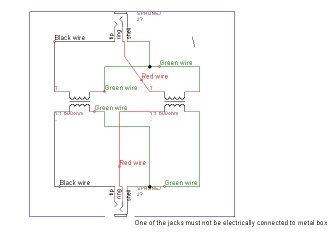
http://www2.lib.uchicago.edu/~dean/blog/isolation-transformer.dsn
Circuit diagram for TinyCAD.
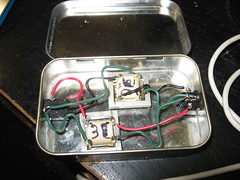

http://www2.lib.uchicago.edu/~dean/blog/isolation-transformer.dsn
Circuit diagram for TinyCAD.

Tuesday, March 01, 2011
Evening passes for the ISS (International Space Station) and the Shuttle in Chicago
A number of visible passes for Chicago this week:
http://www.heavens-above.com/PassSummary.aspx?satid=25544&lat=41.781312&lng=-87.605097&loc=Chicago&alt=0&tz=CST
http://www.heavens-above.com/PassSummary.aspx?satid=25544&lat=41.781312&lng=-87.605097&loc=Chicago&alt=0&tz=CST
Monday, February 21, 2011
Adventures in Large Format Digital Photography: part 6: a new scanner camera
I am starting anew! After I got a bad back moving my box camera around, I've always wanted to reinvigorate the first generation scanner camera I made. It was built around a Agfa Ansco Viking Anastigmat f/6.3 lens from a medium format camera and a wooden mail inbox. The lens has incredible coverage. Here's a look with little modification to the sensor array plastic:

When I used the lens on the first scanner camera with a highly modified sensor, it had coverage of about a 7 inch diameter circle.
The trick is not breaking the new scanner's firmware checking. As soon as I remove the pinhole lens array it started having issues. I had to add the pinhole lens back anytime a particular error message came back. I hesitated to modify the scanner because of the chance of permanent problem.
The new scanner (a Canon LiDE 90) was very sensitive to the position of the glass cover--it was very important to have the glass precisely in place to keep the initialization target in the right place.
Very, very carefully, I used a sharp x-acto knife to remove the plastic tabs and the two new rivets that go through the center of the CIS sensor board. I removed the LED light pipe by finding the tabs that hold it in.
Putting the sensor back immediately made it 'broke'. But I occasionally got it to work. In the end, it appears that unless there is illumination at the instant you hit the preview button in the TWAIN application, you will get the error 2,7,0. I'm still figuring this out.
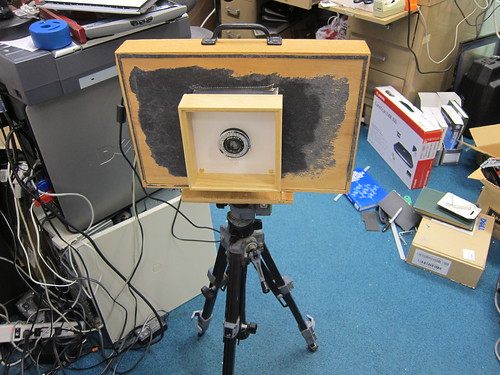

When I used the lens on the first scanner camera with a highly modified sensor, it had coverage of about a 7 inch diameter circle.
The trick is not breaking the new scanner's firmware checking. As soon as I remove the pinhole lens array it started having issues. I had to add the pinhole lens back anytime a particular error message came back. I hesitated to modify the scanner because of the chance of permanent problem.
The new scanner (a Canon LiDE 90) was very sensitive to the position of the glass cover--it was very important to have the glass precisely in place to keep the initialization target in the right place.
Very, very carefully, I used a sharp x-acto knife to remove the plastic tabs and the two new rivets that go through the center of the CIS sensor board. I removed the LED light pipe by finding the tabs that hold it in.
Putting the sensor back immediately made it 'broke'. But I occasionally got it to work. In the end, it appears that unless there is illumination at the instant you hit the preview button in the TWAIN application, you will get the error 2,7,0. I'm still figuring this out.

Saturday, January 29, 2011
The neverending stupidity of astrology and Allstate
I won't get into the long-recognized shifting of the Sun's position and the calendar with regards to the zodiacal signs--as someone who has done a lot of astronomy astrology is one of those things that is like asking a chemist about alchemy--the rolling-eyes chemist can't believe the general public believes you can turn things into gold.
But Allstate, a statistical insurance companies with many many actuaries and other employees incredibly well-versed in mathematics, put out a press release (no longer available) claiming new Virgos were the worst drivers. The Chicago Tribune then put out a story on the press release. The new Ophiuchus was the best driver.
Now, for the shockingly bad details--whomever at Allstate failed to normalize the fact that the new signs have really different lengths--the Sun being in Virgo for a long time as it's a longer constellation (45 days) versus the short 6 day dip in Scorpio. Neither did the Tribune do its diligence in fact-checking this story, leaving it to an anonymous commenter to point out the utter stupidity of it.
I expected better from Allstate. You should have a few of the statisticians on your payroll take the PR people and their management for a little talk. You've lost the confidence of many customers who might know a little science or math, and it's embarrassing to have a company 1. Give a statement in a press release about astrology and 2. Completely get the numbers wrong. I also expected more from the Tribune press--unfortunately it appears companies can just put advertising up for free, caged as PR, and the newspaper will call it a story straight.
But Allstate, a statistical insurance companies with many many actuaries and other employees incredibly well-versed in mathematics, put out a press release (no longer available) claiming new Virgos were the worst drivers. The Chicago Tribune then put out a story on the press release. The new Ophiuchus was the best driver.
Now, for the shockingly bad details--whomever at Allstate failed to normalize the fact that the new signs have really different lengths--the Sun being in Virgo for a long time as it's a longer constellation (45 days) versus the short 6 day dip in Scorpio. Neither did the Tribune do its diligence in fact-checking this story, leaving it to an anonymous commenter to point out the utter stupidity of it.
I expected better from Allstate. You should have a few of the statisticians on your payroll take the PR people and their management for a little talk. You've lost the confidence of many customers who might know a little science or math, and it's embarrassing to have a company 1. Give a statement in a press release about astrology and 2. Completely get the numbers wrong. I also expected more from the Tribune press--unfortunately it appears companies can just put advertising up for free, caged as PR, and the newspaper will call it a story straight.
Tuesday, January 25, 2011
Making Things Talk & Processing projects
I got Making Things Talk as a gift from a great friend of mine and I just ran two of the projects in the "Identification" chapter.
To start off, you install Processing, a free language for visualization. For me the download for Windows was here. It's a slightly different install process than usual; just make a directory like "C:\Program Files\processing-1.2.1" and dump the contents there, and make a shortcut to processing.exe somewhere convenient for you (or you will forget it's installed).
Then in order to do video things you first need to have quicktime installed; if you have iTunes then you've got quicktime. And, finally, you need a VDIG implementation; for Windows it is WinVDIG. Install version 1.01 from here.
The first project was finding a particular color in a webcam image, reading the color, then putting a pointer on that spot.
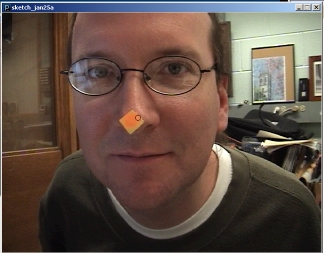
Hey it works! See the dot on my nose?
The screenshot misses the dynamic aspect of the little dot following you around.
The second project was using your imager to decode QR Codes--and ha ha, check out the sample from the book. Nice one, Tom Igoe.
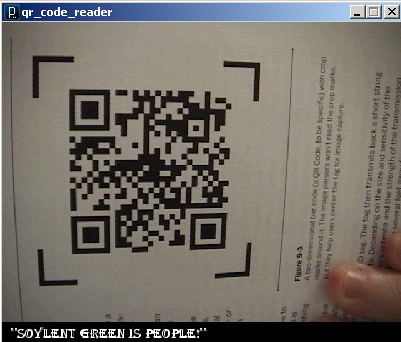
Great stuff.
P.S. I just loaded the 'slitscan' example from the Processing examples. Ha!
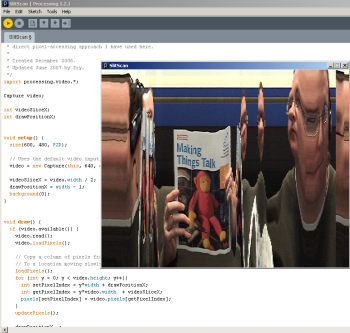
To start off, you install Processing, a free language for visualization. For me the download for Windows was here. It's a slightly different install process than usual; just make a directory like "C:\Program Files\processing-1.2.1" and dump the contents there, and make a shortcut to processing.exe somewhere convenient for you (or you will forget it's installed).
Then in order to do video things you first need to have quicktime installed; if you have iTunes then you've got quicktime. And, finally, you need a VDIG implementation; for Windows it is WinVDIG. Install version 1.01 from here.
The first project was finding a particular color in a webcam image, reading the color, then putting a pointer on that spot.

Hey it works! See the dot on my nose?
The screenshot misses the dynamic aspect of the little dot following you around.
The second project was using your imager to decode QR Codes--and ha ha, check out the sample from the book. Nice one, Tom Igoe.

Great stuff.
P.S. I just loaded the 'slitscan' example from the Processing examples. Ha!

Thursday, January 13, 2011
Monday, January 10, 2011
Two new trends to keep an eye on in 2011 and beyond: 3D printing and Mobile Security
3D printing and mobile security are two big trends to watch.
The next big thing will be 3D printing. It's a hobbyist field right now, with rudimentary designs and machines, but it's going to get better. What happens when you can replicate any physical thing? That part that broke on your dishwasher, your bike, or that toy--you will just make (or buy from some third-party) a replacement. You won't buy the part from the manufacturer (even if you could). Those cheap things that break and then you throw out? Why would you if it could be easily fixed for next to nothing from a machine you had under your desk?
The best approach to this emerging market is to keep it open, free from patents and IP, and let it flourish. Many organizations and business interests will attempt to get a stranglehold on the emerging field, and it's important not to let that happen, lest they stifle the innovation an open field offers. The Internet would absolutely not be what it was if large corporations controlled it.
Dan's Data has an interesting post about the future of 3D printing.
Mobile Security needs to be addressed. We sat with cellular phones in a controlled world with little to worry about, as the oligarchy of carriers strongly restricted what could be run on their phones and networks. That worked at the cost of innovation. The new world of open platforms on the smartphone now means maliciousness is around the corner if the native OS isn't correctly applying security features like sandboxing. We need phones; we use them all the time, all day, and we need to be able to summon people in emergencies. We can't let them break because of bad security. We need to be able to prevent mass Denial-Of-Service, worm outbreaks, malicious breaking of phone security, and surveillance on these devices. And it's not just having the carrier control the phone; mobile security is also about You having control and not letting Them (whether they are a cracker or a malicious app or the Carrier) reading your data.
(While mobile security needs to be addressed as an emerging issue, that in no way reduces the disaster of the current free-for-all in web plug-in security holes).
UPDATE: for instance this finding of SMS messages that can kill nearly any phone.
The next big thing will be 3D printing. It's a hobbyist field right now, with rudimentary designs and machines, but it's going to get better. What happens when you can replicate any physical thing? That part that broke on your dishwasher, your bike, or that toy--you will just make (or buy from some third-party) a replacement. You won't buy the part from the manufacturer (even if you could). Those cheap things that break and then you throw out? Why would you if it could be easily fixed for next to nothing from a machine you had under your desk?
The best approach to this emerging market is to keep it open, free from patents and IP, and let it flourish. Many organizations and business interests will attempt to get a stranglehold on the emerging field, and it's important not to let that happen, lest they stifle the innovation an open field offers. The Internet would absolutely not be what it was if large corporations controlled it.
Dan's Data has an interesting post about the future of 3D printing.
Mobile Security needs to be addressed. We sat with cellular phones in a controlled world with little to worry about, as the oligarchy of carriers strongly restricted what could be run on their phones and networks. That worked at the cost of innovation. The new world of open platforms on the smartphone now means maliciousness is around the corner if the native OS isn't correctly applying security features like sandboxing. We need phones; we use them all the time, all day, and we need to be able to summon people in emergencies. We can't let them break because of bad security. We need to be able to prevent mass Denial-Of-Service, worm outbreaks, malicious breaking of phone security, and surveillance on these devices. And it's not just having the carrier control the phone; mobile security is also about You having control and not letting Them (whether they are a cracker or a malicious app or the Carrier) reading your data.
(While mobile security needs to be addressed as an emerging issue, that in no way reduces the disaster of the current free-for-all in web plug-in security holes).
UPDATE: for instance this finding of SMS messages that can kill nearly any phone.
Subscribe to:
Comments (Atom)
